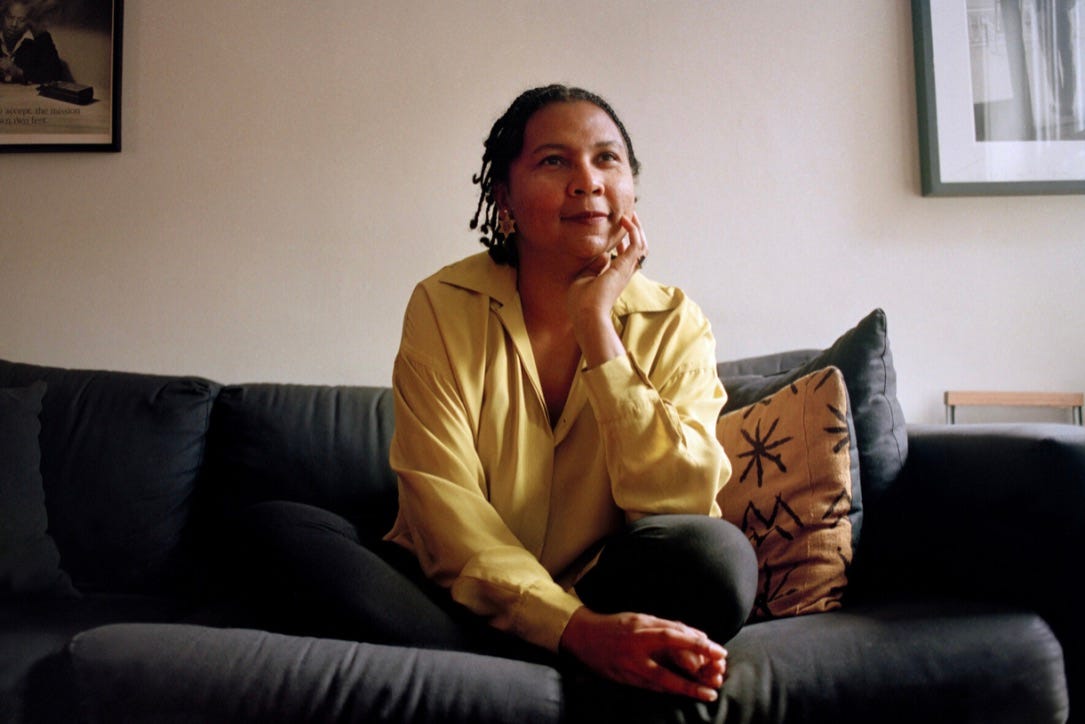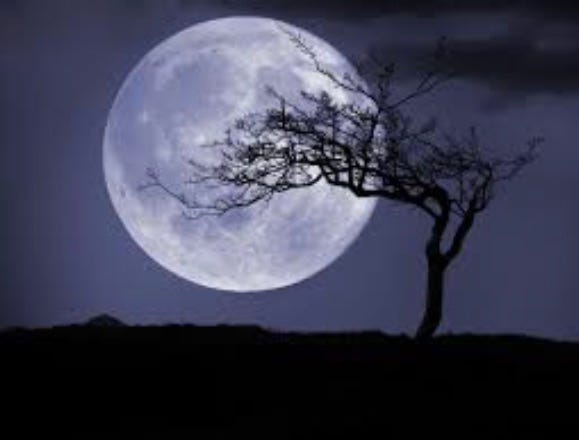December Postcards 12.19.21
Storied Women-of-Letters, "A Life of the Mind".. and "The Light is Always There"
Holiday-season greetings, and happy Sunday from newShrink! (Just two more sleeps until Tuesday’s midmorning Solstice-shift toward longer daylight…)

In light of the season’s pace and priorities this newShrink is again a Postcard edition — this time a smaller number of selected images and vignettes told in more detail through quotes with some of my thoughts. Some pensive and others light, these have caught and drawn eye, head or heart toward quieter corners of this noisy season. (The intensive focus on news events and issues will of course return.)
Selection hasn’t had a rigid structure or intent. What’s shown up and stuck has aligned around some newShrink themes and core concepts from depth/soul-engaged psychology that may be familiar by now. A few examples are here, and you may notice others that I haven’t:
🔷 the idea of living out of the more deeply authentic, “eulogy-” or “soul’s code-” version of ourselves and our life-stories — the Self that’s deeper than the ego-self adopted in our youth to meet demands of culture, family, (and for some, even history);
🔷 the ways our own paths can be informed and deepened by exploring the psychological and personal lives of public and historic figures, both men and women;
🔷 ways the psychological lives of publicly acclaimed women, both historic and contemporary, present examples and models readily relatable to many of today’s headlines and challenges for both the mundane/practical and the intellectual/creative lives of women and those who care about them; and
🔷 the power and pattern of the unconscious soul (the psyche) to make itself known from out of the shadows… in the margins or wings outside the center-stage spotlights of our experiences and stories. Or to use another metaphor also common to many of the contemplative (inner-stillness) religious, spiritual and psychological traditions: The wisdom-voice only heard amid stillness and silence.
Links to stories and more detail on today’s Postcard pieces are in Post Notes at the bottom of today’s edition, listed in the order that they appear.
🔵
storied women-of-letters…
This woman, and her literal eulogy-version life-story in Wednesday’s nationwide news, merits a couple of deeper-dive quotes from coverage by others who knew her and her work. Starting with the New York Times obituary:
bell hooks, Pathbreaking Black Feminist, Dies at 69
She insisted that the fight for women’s rights had to take into account the diverse experiences of working-class and Black women.

“bell hooks, whose incisive, wide-ranging writing on gender and race helped push feminism beyond its white, middle-class worldview to include the voices of Black and working-class women, died on Wednesday at her home in Berea, Ky. She was 69.
Her sister Gwenda Motley said the cause was end-stage renal failure.
Starting in 1981 with her book Ain’t I a Woman? Black Women and Feminism, Ms. hooks, who insisted on using all lowercase letters in her name [both to emphasize her works, not herself, and to honor her great-grandmother by taking her name] argued that feminism’s claim to speak for all women had pushed the unique experiences of working-class and Black women to the margins.
‘A devaluation of Black womanhood occurred as a result of the sexual exploitation of Black women during slavery that has not altered in the course of hundreds of years,’ she wrote.
If that seems like conventional wisdom today, that is in large part because of the enormous impact Ms. hooks had on both feminism and Black women, many of whom had resisted aligning with a movement they felt was designed to diminish their experiences…
… Especially in her later work, Ms. hooks emphasized the importance of community and of healing as the end goal of movements like feminism and antiracism. Some criticized this position as papering over deep social divisions.
But Ms. hooks, who described herself as a ‘Buddhist Christian’ and spoke often of her friendship with the Buddhist monk Thich Nhat Hanh, insisted that love was the only way to overcome what she called the ‘imperialist white supremacy capitalist patriarchy.’ hooks told the philosopher George Yancy in an interview for The New York Times in 2015:
‘I believe wholeheartedly that the only way out of domination is love, and the only way into really being able to connect with others, and to know how to be, is to be participating in every aspect of your life as a sacrament of love.”’
🌀
In an excellent PBS Newshour interview, Princeton University Professor Imani Perry described her experience of hooks on both human and scholarly levels:
“a curate, a person who tended to souls as an educator
She was a teacher to her core, even though I didn't have her in the classroom. She brought ideas alive. She is a person who bridged the space between high critical theory, European scholars and intellectuals… and everyday life…
She wrote and spoke in a way to make all of that theory applicable to our daily lives.
And she wanted it to bear upon the way we thought of each other ethically, our relationships, our personal stories…
She was both an intellectual and she was also a kind of.. a curate, a person who tended to souls as an educator. It allowed me to imagine how to live a life of the mind and yet also to pursue right relation to other human beings in my midst.”
🌀
On hooks I have only a couple of comments to add.
Although as a longtime feminist I’m familiar with hooks, on reading and learning more about her this week I realize I need and now want to revisit and absorb far more deeply.
Of all the powerful quotes highlighted here and statements about hooks, two phrases strike deepest chords worth repeating. First is this one, from my own experiences as a woman and in those of public-figure women both current and historic, of the dynamic tension between the demands of domestic and societally blessed mundane responsibilities of women and the deep pull to life of intellect and creativity:
“She is a person who bridged the space between high critical theory, European scholars and intellectuals… and everyday life…She wrote and spoke in a way to make all of that theory applicable to our daily lives.”
The second eulogizing descriptor that continues to stop me in my tracks — particularly the lovely phrase a life of the mind, which in my view we don’t hear or use nearly often enough these days:
“to imagine how to live a life of the mind… and yet also to pursue right relation to other human beings in my midst.”
These are the stuff of needed daily-reminder mantras… (And maybe a better woman-targeted gift-shop tea towel message than those depicted in last week’s post.)
🔵
Now to our second storied woman: From this week’s news via National Public Radio, an update to what may be history’s ultimate — and literal — depth psychological move of taking charge of the “eulogy-/inside-out-version” of one’s own life story.
Experts crack the secret to last letter of Mary, Queen of Scots

“On the eve of her execution in 1587, Mary, Queen of Scots wrote what is thought to be her very last letter.
She had been imprisoned for nearly 20 years for the perceived threat she represented to Queen Elizabeth I in terms of a takeover of the English throne. With hours to go until her beheading, Mary sat down and penned what researchers say was not only her last will and testament, but also a bid for martyrdom.
To keep her message safe, Mary turned to the 16th-century equivalent of sending an encrypted email — a folding technique known as the spiral lock. Using an elaborate series of slits, folds and tucks, she turned the letter into a piece of tamper-proof priority mail.
Her technique was so elaborate and complex that researchers have struggled throughout modern history to fully understand how she did it. But now, experts at the Massachusetts Institute of Technology and King's College London say they finally have cracked the code.
The spiral lock that Mary used was a particularly elaborate example of a practice known as letterlocking, whereby the letter functions as its own envelope. Until the invention of the modern envelope, letter-locking was common practice for hundreds of years.”
The NPR story doesn’t say what Mary’s letter actually said, an omission I found glaring and rather comically ironic. Which of course put me into high “dog-digging-for-a-bone” mode, finding this entry from englishhistory.net:
“Mary Stuart wrote this letter, completing it just six hours before her execution at Fotheringhay Castle.
It is addressed to her former brother-in-law, King Henry III of France. She had written to him regularly throughout her imprisonment in England. The letter is a remarkable document. Mary clearly believes she is dying as a martyr to her Catholic faith. She also displays genuine concern for the loyal servants who joined her English imprisonment.
It should be noted that Henry III did not provide the wages and pensions which Mary so poignantly seeks here. It was King Philip II of Spain who honored her last wishes.
‘8 February 1587
To the most Christian king, my brother and old ally, Royal brother, having by God’s will, for my sins I think, thrown myself into the power of the Queen my cousin [Elizabeth I], at whose hands I have suffered much for almost twenty years, I have finally been condemned to death by her and her Estates. I have asked for my papers, which they have taken away, in order that I might make my will, but I have been unable to recover anything of use to me, or even get leave either to make my will freely or to have my body conveyed after my death, as I would wish, to your kingdom where I had the honor to be queen, your sister and old ally… ‘“
🌀 Some thoughts
Of course, much as would be the case today, the questions of historic truth and journalistic fact here must be considered within power contexts such as the political and religious. (After all, this was the same “Bloody Mary” so-named for horrific persecution and burning at the stake of her Protestant subjects for refusing to convert to her Catholicism during her earlier five-year reign.)
So with Mary Stuart and her cousin Elizabeth I, considering contexts means succession to the throne in monarchies and divine right of kings (and queens) in such theocratic monarchies as the historic British one. (Volumes, historic decades and bloodshed have been devoted solely to relations and power dynamics between British monarchs, the Catholic Church and the Church of England, for example.)
Meanwhile, in the present day, the remarkable technology and effectiveness of Mary’s privacy-security has near-eerie relevance in terms of journalism delivery systems, communication technology and privacy issues as well as cybersecurity.
Shifting to the psychological/soul perspective, with this heavily “encrypted” letter Mary Stuart quite literally embodies the push toward looping or spiraling-back of the “eulogy” version of life story (versus just the linear, factual historic record). It seems clear Mary is making the effort to revisit and tell her side of her own story, in her own voice, after some 20 years in prison and before what will be marked as one of the most gruesome of executions (not that there are any nice ones.)
Now, I have no idea whether Mary is disseminating fact or propaganda here — and I think maybe that’s immaterial. For me this deathbed act of hers gets at a deep — perhaps even archetypal, ie. across-cultures and history — human inclination and push to the telling of what we believe to be our full truth, the whole-truth-and-nothing-but, particularly when closer to the end than the beginning of our life stories. Perhaps it is at the core of ritual such as last rites, funerals… and yes, that literal “eulogy” of our lives.
(All of which has me imagining and reflecting on just what deathbed missives and scenarios might eventually play themselves out in our halls of power and politics today… assuming many of the players understand that they are mortal.)
Some personal disclosure here… With this Mary Stuart story it’s been a synchronistic connection with the phrase, description and image spiral lock on her letter that has seized my attention since the story showed up in my news feed, rather zapping me, this past Wednesday (12.15.) For since a week earlier (on 12.8) I had been puzzling over a dream-image of a steel or titanium spiral so vivid and strange I’d even been drawing/doodling to see if any connections or meanings came to mind.
As I’ve discussed previously in newShrink editions, the idea of our human experience of our lives as a spiraling, looping-back-then carrying forward process more like weaving than linear steps, is a core concept in depth psychology, particularly that of Jung and Hillman.
With Dante the spiral also illustrates the tersa rima (aba, bcb, cdc etc.) rhyme scheme of his The Divine Comedy — which was the poet’s account of his own initiation experience and individuation “journey to hell and back” as depicted by the work.
And then there’s perhaps my favorite, Nabokov’s compelling description in Speak, Memory, of the spiral as “a spiritualized circle… A colored spiral in a small ball of glass, this is how I see my own life.”
All of which is likely to have me hanging out awhile to ponder these letter-locks employed by this fascinating doomed monarch. (Meanwhile, those Bloody Mary-toasts might best wait until some later mornings!) A couple of other, more detailed pieces on Mary — including pretty gruesome details about her execution — are in the Post Notes below. You might want to proceed with caution on exploring those, perhaps after festive holidays (if at all.)
🔵
Leaning now toward the still points and silences amid this noisy season, here are voices from some of the contemplative practices of various spiritual, religious as well as depth psychology traditions. First, another lovely share, this one in the Buddhist tradition, from friend, reader and longtime journalist Ann Ahern Allen.
“the light is always there…”
From the Buddhist journal Tricycle, by Tenzen Wangyal Rinpoche
“There is no better protection than the refuge of unbounded, sacred space, infinite awareness and genuine warmth.”
Rinpoche describes stillness, silence and open-hearted warmth as the three doorways to inner refuge that help to bring us beyond the ego-self (into the realm of the soul-Self, in depth-psychology terms.)
🔵
From the depth psychology perspective, here is Jung’s heartfelt response to a letter from a woman seeking his counsel on how one ought to live. This was shared this week in Maria Popova’s Marginalian newsletter (formerly Brain Pickings, which by the way had been a favorite title I have referenced here. I am lamenting the name-change, though her peerless content is still wonderful.)
C. G. Jung on How to Live and the Origin of “Do the Next Right Thing”
“There is no pit you cannot climb out of provided you make the right effort at the right place… do the next thing with diligence and devotion….
There is no single, definite way for the individual which is prescribed for him or would be the proper one. If that’s what you want you had best join the Catholic Church, where they tell you what’s what. Moreover this way fits in with the average way of mankind in general. But if you want to go your individual way, it is the way you make for yourself, which is never prescribed, which you do not know in advance, and which simply comes into being of itself when you put one foot in front of the other. If you always do the next thing that needs to be done, you will go most safely and sure-footedly along the path prescribed by your unconscious — your soul.”
Now for some lighter notes…
🔵
Here’s a comic tribute to my lifelong soft spot for the scribe/writer and the contemplative monk — both within, and among, us…
🔵
And this, from reader, gifted singer and writer Pamela McMahon Miller, my neighborhood- and school-friend since 6th grade and still in touch from her various locales on both sides of the pond. For those of us now one or two sugar-buzzes way beyond sweetly festive holiday cheer:
… a look ahead
Next week’s newShrink year-in-review Postcards will be some form of short, 21-quote newShrink farewell to 2021, revisiting material both serious and not… (and maybe even an earworm-from-the-psyche playlist!)
Early January will naturally bring heavy focus back on news with the political year heating up, one-year anniversaries of both the January 6 attack on the Capitol and the Biden presidency… and always plenty more.
Two closing notes, if you are doing any holiday viewing please catch this morning’s CBS teen-musical piece from the echoing Museum of Natural History that caught me from another room as I post this. And in streaming…
🔷 The Ted Lasso “Carol of the Bells” Christmas episode (Season 2, #4) is a fresh and funny/touching one to revisit as a possible new holiday tradition; and
🔷 If you see or have already enjoyed the Disney+ Beatles documentary Get Back and have any thoughts to share, I’d love to hear them as I’m starting it now. Speaking of ear-worms: If there were a theme song to newShrink, since its early conceptual stages well over a year ago it’s been Hey Jude playing on continuous background loop. In that process during reading Joe Biden’s eloquent memoir of his 2015 withdrawal from public life to mourn the death of his son Beau, the song kept coming to mind as a sort of grief-healing anthem with many of its lines, such as “let it out and let it in…”. It resounds as a deeply psychological, and psychotherapeutic, song — applying equally to all theories for what the song is about. Do send me any Beatle thoughts!
🔵
Meanwhile, I leave you with wisdom from one of the other ageless, timeless thinkers:
And, that is all I have! Talk to you next week.
🦋💙tish
… it is important that awake people be awake,
or a breaking line may discourage them back to sleep;
the signals we give — yes or no, or maybe —
should be clear: the darkness around us is deep.
— William Stafford, “A Ritual to Read to Each Other”

🌀🔵🔷🦋💙
Post Notes
https://www.nytimes.com/2021/12/15/books/bell-hooks-dead.html?referringSource=articleShare
https://www.pbs.org/newshour/amp/show/remembering-bell-hooks-and-her-enormous-legacy
https://www.pbs.org/newshour/amp/arts/bell-hooks-groundbreaking-feminist-thinker-dies-at-69
https://www.npr.org/2021/12/14/1062790520/mary-queen-of-scots-letterlocking-spiral-lock
https://englishhistory.net/tudor/mary-queen-scots-last-letter/
https://www.themarginalian.org/2021/12/07/carl-jung-next-right-thing/








